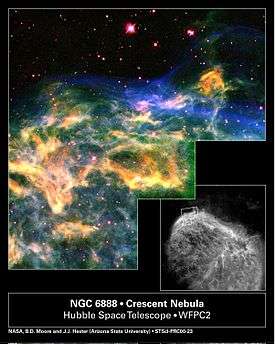WR 136
 WR 136 | |
| Observation data Epoch J2000 Equinox J2000 | |
|---|---|
| Constellation | Cygnus |
| Right ascension | 20h 12m 06.5421s[1] |
| Declination | +38° 21′ 17.779″[1] |
| Apparent magnitude (V) | 7.50[2] |
| Characteristics | |
| Spectral type | WN6(h)-s[3] |
| U−B color index | -0.37[2] |
| B−V color index | 0.01[2] |
| Astrometry | |
| Radial velocity (Rv) | −21.6[4] km/s |
| Proper motion (μ) | RA: −7.54[1] mas/yr Dec.: −7.38[1] mas/yr |
| Parallax (π) | 0.31 ± 0.23[5] mas |
| Distance | approx. 11,000 ly (approx. 3,000 pc) |
| Absolute magnitude (MV) | −4.7[3] |
| Details | |
| Mass | 15[3] M☉ |
| Radius | 3.34[3] R☉ |
| Luminosity | 260,000[3] L☉ |
| Temperature | 70,800[3] K |
| Rotation | 37[6] |
| Age | 4.7[7] Myr |
| Other designations | |
| Database references | |
| SIMBAD | data |
WR 136 is a Wolf–Rayet star located in the constellation Cygnus. It is in the center of the Crescent Nebula. Its age is estimated to be around 4.7 million years and it is nearing the end of its life. Within a few hundred thousand years, it is expected to explode as a supernova.[7]
Features
According to recent estimations, WR 136 is 250,000 times brighter than the Sun, 15 times more massive, and 3.3 times larger. Its surface temperature is around 70,000 kelvins.[3]
WR 136 blew off a shell of material when it became a red supergiant around 120,000-240,000 years ago with a mass of around 5 M☉ and this is still expanding at 80 km/s.[8] Currently, its fast stellar wind, ejected from the star at around 3.8 million mph (1,700 km/s[9]), is catching up to the material ejected from the star and shaping it into a shell. Ultraviolet rays emitted from WR 136's hot surface cause the shell to glow.[8]
There's certain evidence WR 136 may be a binary star. Its companion would be a low-mass star of spectral classification K or M that would complete an orbit around the Wolf-Rayet star each 5.13 days, being the progenitor of a low-mass X-ray binary system.[10]
References
- 1 2 3 4 Van Leeuwen, F. (2007). "Validation of the new Hipparcos reduction". Astronomy and Astrophysics. 474 (2): 653. arXiv:0708.1752. Bibcode:2007A&A...474..653V. doi:10.1051/0004-6361:20078357.
- 1 2 3 Ducati, J. R. (2002). "VizieR Online Data Catalog: Catalogue of Stellar Photometry in Johnson's 11-color system". CDS/ADC Collection of Electronic Catalogues. 2237: 0. Bibcode:2002yCat.2237....0D.
- 1 2 3 4 5 6 7 Hamann, W.-R.; Gräfener, G.; Liermann, A. (2006). "The Galactic WN stars. Spectral analyses with line-blanketed model atmospheres versus stellar evolution models with and without rotation". Astronomy and Astrophysics. 457 (3): 1015. arXiv:astro-ph/0608078. Bibcode:2006A&A...457.1015H. doi:10.1051/0004-6361:20065052.
- ↑ Barbier-Brossat, M.; Petit, M.; Figon, P. (1994). "Third bibliographic catalogue of stellar radial velocities (Text in French)". Astronomy and Astrophysics Supplement Series. 108: 603. Bibcode:1994A&AS..108..603B.
- ↑ Gaia Collaboration (2016). "VizieR Online Data Catalog: Gaia DR1 (Gaia Collaboration, 2016)". VizieR On-line Data Catalog: I/337. Originally published in: Astron. Astrophys. 1337. Bibcode:2016yCat.1337....0G.
- ↑ Gräfener, G.; Vink, J. S.; Harries, T. J.; Langer, N. (2012). "Rotating Wolf-Rayet stars in a post RSG/LBV phase". Astronomy & Astrophysics. 547: A83. arXiv:1210.1153. Bibcode:2012A&A...547A..83G. doi:10.1051/0004-6361/201118664.
- 1 2 Moore, Brian D.; Hester, J. Jeff; Scowen, Paul A. (2000). "[ITAL]HUBBLE SPACE TELESCOPE[/ITAL][ITAL]Hubble Space Telescope[/ITAL] Observations of the Wolf-Rayet Nebula NGC 6888". The Astronomical Journal. 119 (6): 2991. arXiv:astro-ph/0003053. Bibcode:2000AJ....119.2991M. doi:10.1086/301389.
- 1 2 Mesa-Delgado, A.; Esteban, C.; García-Rojas, J.; Reyes-Pérez, J.; Morisset, C.; Bresolin, F. (2014). "The Trace of the CNO Cycle in the Ring Nebula NGC 6888". The Astrophysical Journal. 785 (2): 100. arXiv:1402.6181. Bibcode:2014ApJ...785..100M. doi:10.1088/0004-637X/785/2/100.
- ↑ Hamann, W.-R.; Wessolowski, U.; Koesterke, L. (1994). "Non-LTE spectral analyses of Wolf-Rayet stars: The nitrogen spectrum of the WN6 prototype HD 192163 (WR136)". Astronomy and Astrophysics. 281: 184. Bibcode:1994A&A...281..184H. ISSN 0004-6361.
- ↑ Rustamov, D. N.; Cherepashchuk, A. M. (2011). "The Wolf-Rayet star HD 192163 as a possible evolutionary progenitor of a low-mass X-ray binary". Astronomy Reports. 55 (4): 347–358. Bibcode:2011ARep...55..347R. doi:10.1134/S1063772911010069. Retrieved 17 July 2013.
Further reading
- Bychkov, K. V.; Sitnik, T. G. (2006). "Stratification of optical emission from NGC 6888 as a trace of the interaction between Wolf-Rayet stellar wind and the shell of a red supergiant". Astronomy Letters. 32 (6): 406. Bibcode:2006AstL...32..406B. doi:10.1134/S1063773706060041.